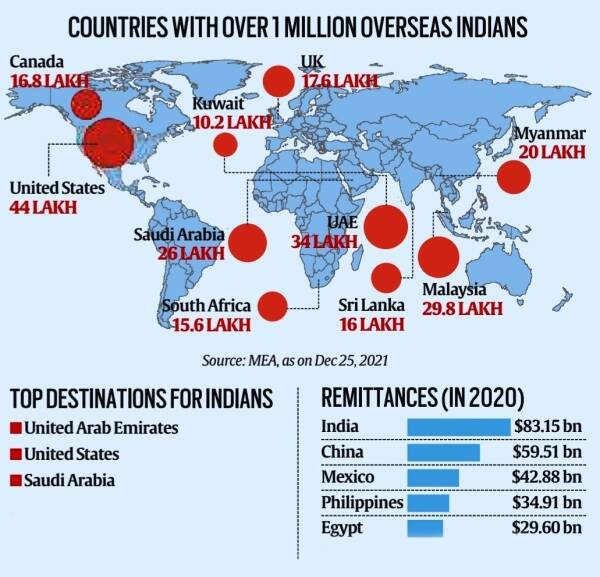The Indian Diaspora | 10 Jan 2023
For Prelims: Pravasi Bharatiya Diwas (PBD), Non-Resident Indians (NRI), Persons of Indian Origin (PIOs), Overseas Citizens of India (OCIs)
For Mains: Indian Diaspora - Significance
Why in News?
Recently, the Prime Minister inaugurated the 17th Pravasi Bharatiya Diwas convention in Madhya Pradesh on the occasion of Pravasi Bhartiya Diwas (PBD).
- Over the years, the convention, which began in 2003, has grown in size and scope, particularly since 2015, when the yearly convention became a biennial affair.
What is Diaspora?
- Origin:
- The term diaspora traces its roots to the Greek diaspeiro, which means dispersion. The Indian diaspora has grown manifold since the first batch of Indians were taken to counties in the eastern pacific and the Caribbean islands under the ‘Girmitiya’ arrangement as indentured labourers.
- Classifications:
- Non-Resident Indians (NRI): NRIs are Indians who are residents of foreign countries. A person is considered NRI if:
- She/he is not in India for 182 days or more during the financial year Or;
- If he/she is in India for less than 365 days during the 4 years preceding that year and less than 60 days in that year.
- Persons of Indian Origin (PIOs): PIO refers to a foreign citizen (except a national of Pakistan, Afghanistan Bangladesh, China, Iran, Bhutan, Sri Lanka and Nepal) who:
- At any time held an Indian passport, or who or either of their parents/ grandparents/great grandparents was born and permanently resided in India as defined in the Government of India Act, 1935 or who is a spouse of a citizen of India or a PIO.
- The PIO category was abolished in 2015 and merged with the OCI category.
- At any time held an Indian passport, or who or either of their parents/ grandparents/great grandparents was born and permanently resided in India as defined in the Government of India Act, 1935 or who is a spouse of a citizen of India or a PIO.
- Overseas Citizens of India (OCIs): A separate category of OCI was carved out in 2005. An OCI card was given to a foreign national:
- Who was eligible to be a citizen of India on January 26, 1950
- Was a citizen of India on or at any time after January 26, 1950 or belonged to a territory that became part of India after August 15, 1947.
- Minor children of such individuals, except those who were a citizen of Pakistan or Bangladesh, were also eligible for OCI cards.
- Non-Resident Indians (NRI): NRIs are Indians who are residents of foreign countries. A person is considered NRI if:
- Geographical Spread:
- According to the World Migration Report, 2022, India has the largest emigrant population in the world in 2020, making it the top origin country globally, followed by Mexico, Russian and China.
- The data shared by the government in Parliament in 2022 showed that the geographical spread of the Indian diaspora is vast. The countries with over 10 lakh overseas Indians include:
- United States of America, the United Kingdom, United Arab Emirates, Sri Lanka, South Africa, Saudi Arabia, Myanmar, Malaysia, Kuwait and Canada.
- Remittances:
- According to the World Bank Migration and Development Brief, released in 2022, for the first time a single country, India, is on track to receive more than USD 100 billion in yearly remittances.
- The World Migration Report notes that India, China, Mexico, the Philippines and Egypt are (in descending order) among the top five remittance recipient countries.
What is the Significance of the Indian Diaspora?
- Enhancing India’s Soft Power: Indian diaspora is one of the richest minorities in many developed countries. Their advantage is evident in “diaspora diplomacy”, whereby they act as “bridge-builders” between their home and adopted countries.
- The Indian diaspora is not just a part of India’s soft power, but a fully transferable political vote bank as well.
- Also, many people of Indian origin hold top political positions in many countries, which enhances India’s political clout at multilateral institutions like the United Nations.
- Economic Contribution: Remittances sent by the Indian diaspora have positive systemic effects on the Balance of Payments (BOP), which help to bridge a wider trade deficit.
- The migration of less-skilled labor (especially to West Asia) has helped in bringing down disguised unemployment in India.
- Further, the migrant workers facilitated the flow of tacit information, commercial and business ideas, and technologies into India.
UPSC Civil Services Examination, Previous Year Question (PYQ)
Q. ‘Indian diaspora has a decisive role to play in the politics and economy of America and European Countries’. Comment with examples. (2020)

